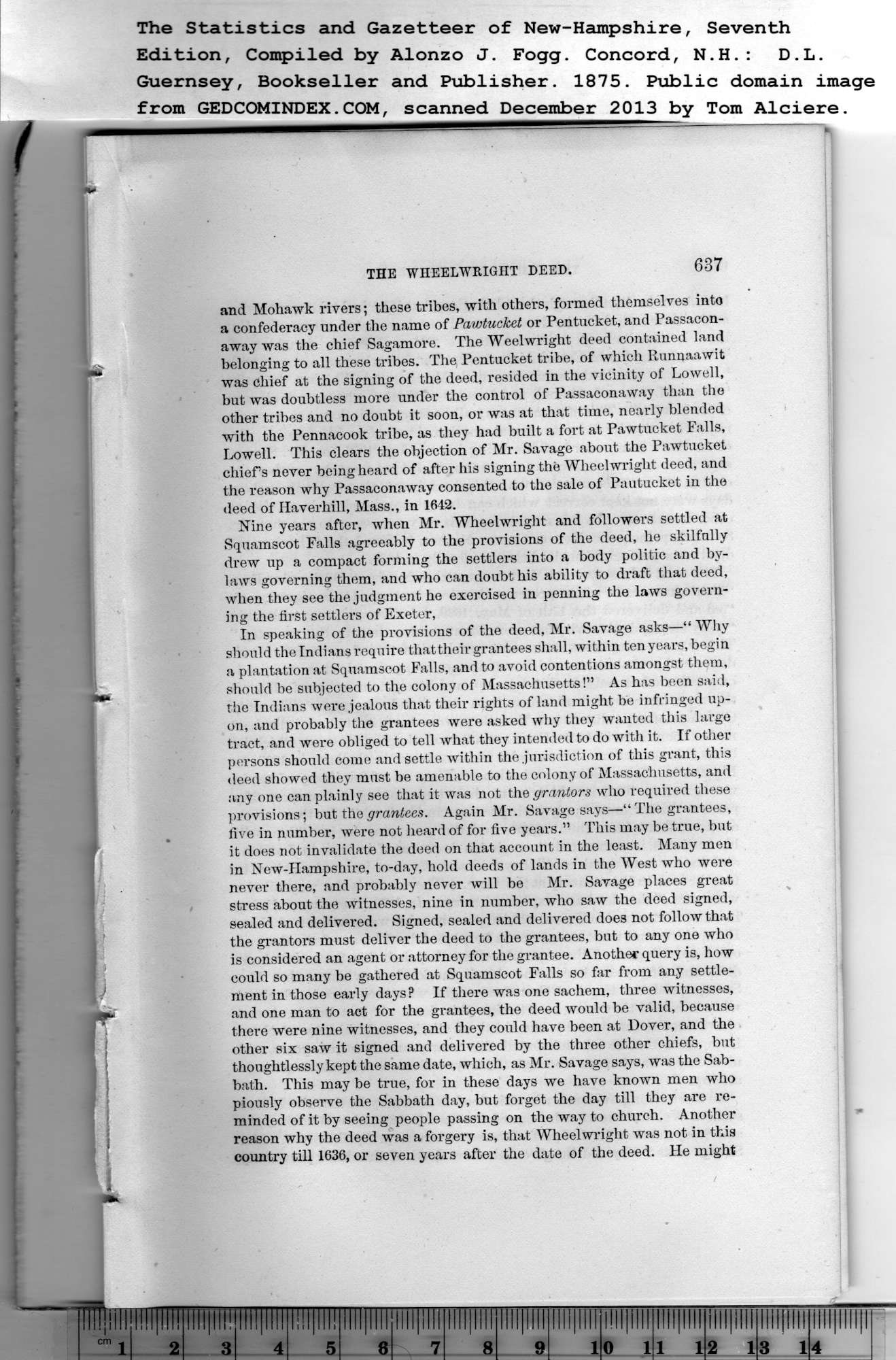|
637
THE WHEELWRIGHT DEED.
and Mohawk rivers; these tribes, with others, formed themselves into
a confederacy under the name of Pawtucket or Pentucket, and Passacon-
away was the chief Sagamore. The Weelwright deed contained land
belonging to all these tribes. The Pentucket tribe, of which Runnaawit
was chief at the signing of the deed, resided in the vicinity of Lowell,
but was doubtless more under the control of Passaconaway than the
other tribes and no doubt it soon, or was at that time, nearly blended
with the Pennacook tribe, as they had built a fort at Pawtucket Falls,
Lowell. This clears the objection of Mr. Savage about the Pawtucket
chief’s never being heard of after his signing the Wheelwright deed, and
the reason why Passaconaway consented to the sale of Pautucket in the
deed of Haverhill, Mass., in 1642.
Nine years after, when Mr. Wheelwright and followers settled at
Squamscot Falls agreeably to the provisions of the deed, he skilfully
drew up a compact forming the settlers into a body politic and by-
laws governing them, and who can doubt his ability to draft that deed,
when they see the judgment he exercised in penning the laws govern-
ing the first settlers of Exeter,
In speaking of the provisions of the deed, Mr. Savage asks—“ Why
should the Indians require that their grantees shall, within ten years, begin
a plantation at Squamscot Falls, and to avoid contentions amongst them,
should be subjected to the colony of Massachusetts!” As has been said,
the Indians were jealous that their rights of land might be infringed up-
on, and probably the grantees were asked why they wanted this large
tract, and were obliged to tell what they intended to do with it. If other
persons should come and settle within the jurisdiction of this grant, this
deed showed they must be amenable to the colony of Massachusetts, and
.any one can plainly see that it was not the grantors who required these
provisions; hut the grantees. Again Mr. Savage says—“ The grantees,
five in number, were not heard of for five years.” This may be true, but
it does not invalidate the deed on that account in the least. Many men
in New-Hampshire, to-day, hold deeds of lands in the West who were
never there, and probably never will be Mr. Savage places great
stress about the witnesses, nine in number, who saw the deed signed,
sealed and delivered. Signed, sealed and delivered does not follow that
the grantors must deliver the deed to the grantees, but to any one who
is considered an agent or attorney for the grantee. Another query is, how
eould so many he gathered at Squamscot Falls so far from any settle-
ment in those early days ? If there was one sachem, three witnesses,
and one man to act for the grantees, the deed would be valid, because
there were nine witnesses, and they could have been at Dover, and the
other six saw it signed and delivered by the three other chiefs, but
thoughtlessly kept the same date, which, as Mr. Savage says, was the Sab-
bath. This may be true, for in these days we have known men who
piously observe the Sabbath day, but forget the day till they are re-
minded of it by seeing people passing on the way to church. Another
reason why the deed was a forgery is, that Wheelwright was not in this
country till 1636, or seven years after the date of the deed. He might
PREVIOUS PAGE ... NEXT PAGE
This page was written in HTML using a program written in Python 3.2
|
